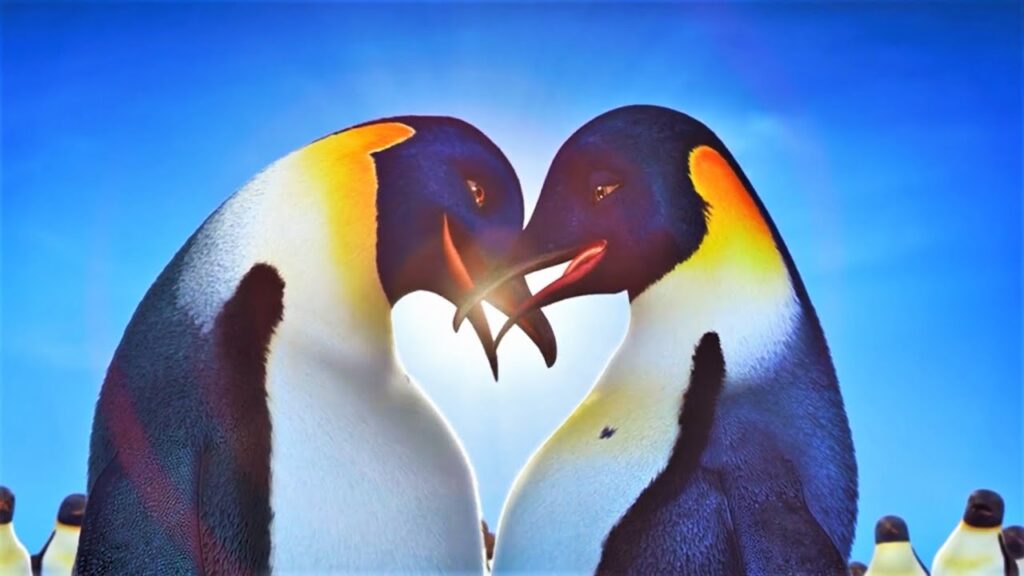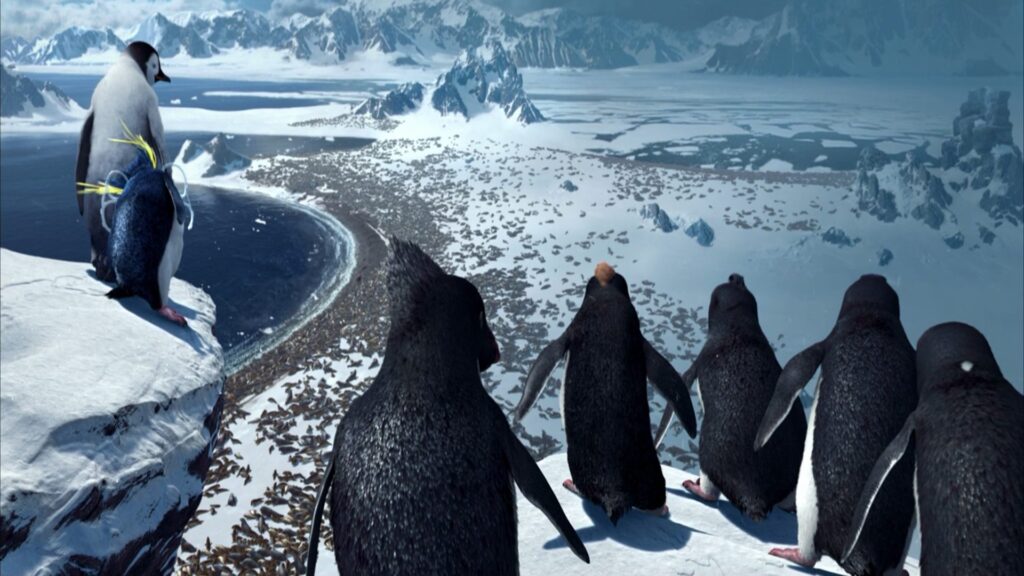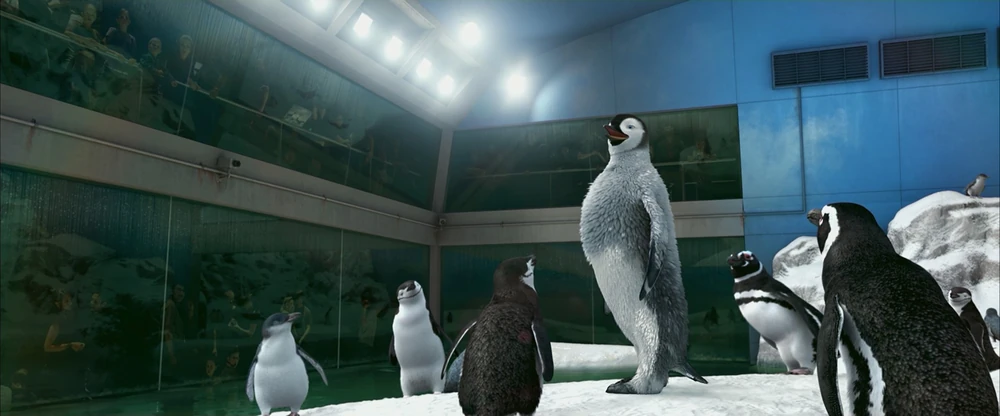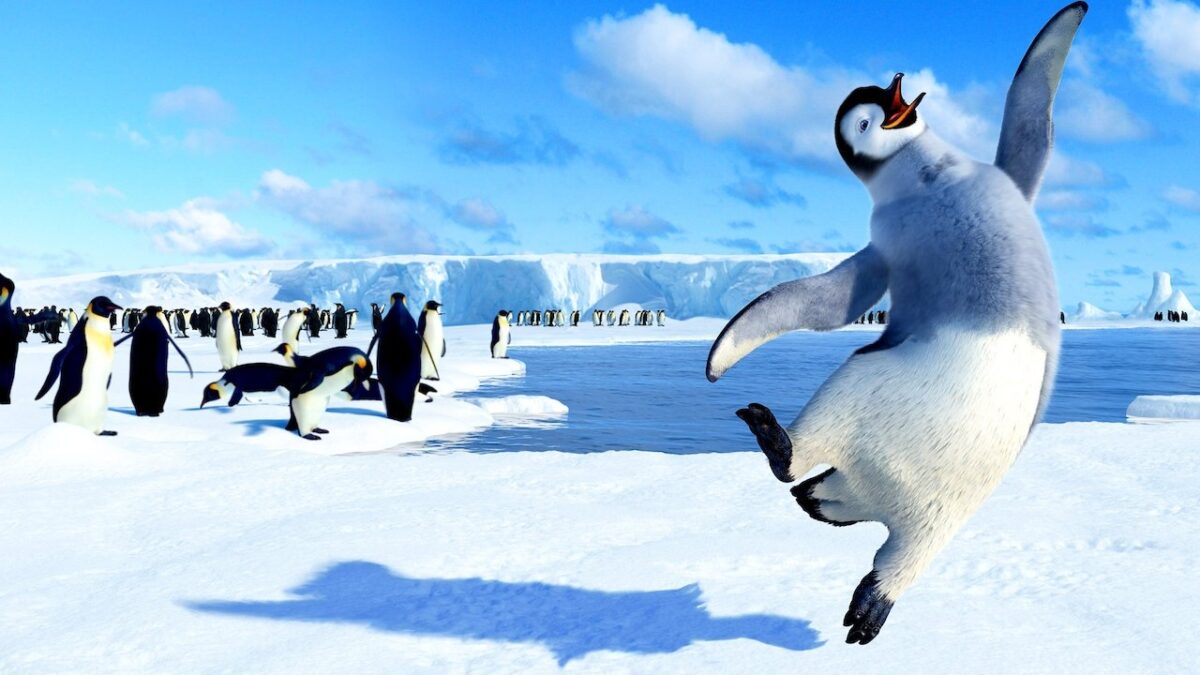Stay cool, bird boy
George Miller is either mad or a genius — or very likely both. How else do you explain the creator of Mad Max, a guy who made his name with road warriors and Ozploitation, making an animated movie about tap-dancing penguins? If you described this project in the early 1990s, it would have sounded like an SNL joke. And it’s no half-assed trifle. Happy Feet marks not just a(nother) detour into family filmmaking, but a full-blown auteur animation project that would win a damn Oscar.
Happy Feet is a curio even within the pond of 2000s animation. It’s part jukebox musical, part hero’s journey, part ecological fable, and all visionary technical exercise. The tone swings between music video exuberance through operatic drama, stitched together by a visual sensibility that’s both digitally pristine and expressive. Though it’s Miller’s first animated feature, it doesn’t feel like a freshman effort; rather, it extends the visual experimentation of his live-action work.
In that sense, Happy Feet is a natural outgrowth of the two Babe films, the first of which Miller just produced, the second of which he directed. Like those films, it channels takes a family-oriented fairy tale and applies some cutting-edge visual technology to bring it to life. But Happy Feet turns up the volume: it’s weirder, bigger, and more ambitious than the Babes. Miller adopts some conventions of the CGI comedy — quipping, caricatured, celebrity-voiced animals especially — without ever settling into the formula.

The film is set in the Antarctic emperor penguin society during their mating cycle. Each bird attracts a mate by singing a unique “heartsong,” a melody that expresses the core of who they are, and a romanticizing of the real-life trait of penguins identifying partners by their distinct vocalization. Mumble (Elijah Wood), a penguin chick who barely survived his hatching, has a glitch — he can’t sing to save his life. But when his oversized feet start tapping, he discovers a new form of self-expression, one that the penguin elders regard with suspicion and scorn.
The early stretch of the film charts Mumble’s birth and growth as an outsider. His parents, Memphis (Hugh Jackman) and Norma Jean (Nicole Kidman) — inspired by ‘50s icons Elvis and Marilyn Monroe, respectively — meet and fall in love to an opening medley. When he hatches, Mumble’s dancing earns ridicule from his peers and disappointment from his father while his mom is off hunting fish. Mumble eventually finds kinship in the Amigos, a group of rambunctious Adélie penguins (stylized and vocalized as an ethnic gang of greasers) who welcome his eccentricities. They include Ramon, memorably voiced by Robin Williams doing a silly voice. (Though nowhere close to the level of Robin Williams hurricane of ham in, e.g. Aladdin.)
From a narrative and texture perspective, Happy Feet’s first act very much resembles the post-Shrek DreamWorks Animation playbook: quirky protagonist, pop soundtrack, sassy supporting cast, some light moralizing, anachronistic jokes, and a message about individuality wrapped around its misunderstood outsiders. But even in these more conventional opening minutes, Happy Feet has an idiosyncratic flavor. First is the wildly ambitious camera movement and photorealism; it’s not at the level that Pixar was at in the mid-to-late-aughts, but it’s better than most others of the era trying CGI features, and it’s certainly the most ambitious in rendering natural environments of its generation. Miller emphasizes realistic animal movement, particularly in how the penguins waddle and emote, set against harrowing icy vistas. Instead of flattening the world into cartoon abstraction, Miller makes it feel big and cold and even menacing.

One of the movie’s weirdest contradictions is how totally unsuited penguins are to dance. They are bowling pins with beaks. It genuinely makes me wonder if Miller pursued the film’s pitch with irony — singing and dancing animal musical, but it’s with realistic animals that it’s impossible to imagine tap dancing. Seeing emperor penguins groove just never looks quite right, and I genuinely can’t decide if I like that about Happy Feet. Their inherent awkwardness adds comedy and uncanniness to Mumble’s gift. That tension between groundbreaking animation and childlike storytelling is part of Miller’s vision, I think.
(Edit: I’ve been called out on the above point on The Goods’ Discord. Penguins tap-dancing is a long-standing cultural image that Miller is playing on, dating at least to Mr. Popper’s Penguins and Mary Poppins, and probably further. I still think it looks goofy and unnatural.)
Despite the anatomical absurdity, the dance sequences work surprisingly well from a staging perspective. That’s largely thanks to Miller’s direction and the performance capture acting of Savion Glover, who is mapped onto Mumble’s flippers and feet. The musical numbers are kinetic and joyful to watch, with the camera gliding and spinning with fluidity. Miller brings the same action sensibility to a group tap-dance as he does to a car chase in Mad Max.
But let’s not dwell on the opening too much, because after the first act, the movie takes a turn. Mumble’s personal journey gives way to an epic parable about ecological collapse — Miller explores the crumbling of the Antarctic ecosystem and psychological effect it has on the animal societies. He ties it directly to human activities. The tonal shift is bold and a bit unhinged in its swerves like Pig in the City and The Witches of Eastwick. What begins as a lightweight musical becomes weirdly austere, even didactic. Finding Nemo is one obvious inspiration, particularly as Mumble goes through an odyssey encountering a variety of sea and ice dangers — memorably, a chase with a leopard seal — including a face-to-face encounter with humans. But it’s more severe than in the equally-dangerous Nemo; there’s no sense of delightful misadventure in Mumble’s reckoning with danger.
By the third act turn, the movie drops nearly all dialogue and plunges Mumble into a quest against pollution and overfishing. It includes an eerie, near-silent aquarium sequence that is deeply unsettling, bordering on horror-tinged. We witness Mumble completely entrapped in glass, his movements desperate and alien to the probing gawkers. Mumble looks back on his past with retrospection bordering on hallucination.
I’m not entirely convinced this later stretch works as character-based narrative escalation — the story’s emotional throughline of “be yourself” is diluted by the environmentalism parable. But as a swing-for-the-fences story with stark visuals (blending in some real-life humans into the CGI) and a climactic payoff on the growing sense of dread throughout the film, the final act is gutsy, and it remains bracing two decades later.

The audacity of Happy Feet is backed by a titanic production effort. To pull off the film’s complex choreography and detailed environments, Miller and his team at Animal Logic invested heavily into improving the studio’s animation tech and innovative motion capture tools. They mapped human dancers onto animals — star Glover even attended “penguin school” to master the species’ waddling gait. An IBM-built server farm crunched millions of rendering hours for environmental and effect animation to compete with the polish of established studios. Even though the aims of photorealism in the character designs lend the visuals an odd, uncanny flavor, it undoubtedly looks like Miller wanted it to, extremely impressive given the context.
The film’s genesis came from a throwaway comment during the making of Mad Max 2, when a cameraman suggested Miller film something in Antarctica as a counterpoint to the hot, dry landscapes of Australia. That notion stuck in the director’s brain, and when production on the fourth Mad Max movie stalled, Miller and producer Doug Mitchell fast-tracked Happy Feet instead.
In hindsight, Miller’s pause on Mad Max: Fury Road and pivot into penguins looks like an ingenious detour. Throughout Happy Feet, Miller built crucial skills — spatially fluid action, CGI choreography, orchestrating huge crowds in digitally crafted settings — that he would use to reinvent R-rated action cinema a decade later. The Mad Maxes and the Happy Feetses are both obsessed with physical movement, operate in vast, hostile environments, and feature societies grappling with tradition and survival. It’s no exaggeration to say Fury Road might not exist in its ultimate form without Happy Feet (and its even stranger sequel).

In the broader cultural memory, Happy Feet often gets lumped in with the mid-2000s penguin wave: March of the Penguins, Surf’s Up, Madagascar, the Pingu revival, Club Penguin, etc. The Pokemon games that launched in that era, Diamond and Pearl, had a penguin-themed evolution line as its water starters (Piplup-Prinplup-Empoleon). For whatever reason, our Antarctic friends became inescapable for a few years. (I suspect rising awareness of melting ice caps and climate change, key focuses for both Happy Feet and March of the Penguins, is related.)
Miller’s strange swerve into animation paid off, at least financially: the film was a major hit, grossing nearly four times its budget and walking away with the Academy Award for Best Animated Feature — still the only Oscar that Miller’s personally pocketed. It also stands as a flex: proof the visionary can do it all; a bold visual experiment of mocap, environmental effect rendering, and digital camera movement disguised as family entertainment, a stealth auteur work rather than a cheap mainstream sellout you might fear when you learn the Mad Max guy got a budget and made a CGI family comedy.
Happy Feet is less than the sum of its parts, I fear, but those parts are indeed so varied and bold. It’s tonally inconsistent and structurally unusual. It is never lacking in flavor or ambition or ideas. It was also not the end of the Happy Feet saga: With Happy Feet Two five years later, Miller would double down on the bizarre tension of tones and stakes, resulting in an even stranger and more uneven follow-up. Luckily, Happy Feet has enough moves to keep me curious for more.
- Review Series: George Miller
Is It Good?
Good (5/8)
Dan is the founder and head critic of The Goods. Follow Dan on Letterboxd. Join the Discord for updates and discussion.

